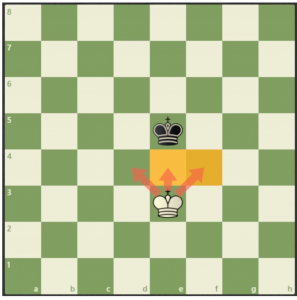Opposition
Let’s talk about opposition in chess, particularly its importance in the endgame. Opposition is when one king moves directly in front of the other, forcing the opposing king to move to the side or backwards.

This concept is crucial for advancing your position and is often used when you have a king and pawn trying to promote the pawn to a queen. By gaining opposition, you can force the opposing king to give way, allowing your pawn to advance and eventually promoting it.
White to Play
For example, if it’s your turn to move and your king is directly in front of the opponent’s king, the opponent must move to the side or back for you to continue advancing. This tactic can be used to escort a pawn to promotion, ensuring victory. If the opponent’s king tries to stop your pawn, gaining opposition allows you to outmanoeuvre them and create a path for your pawn.
Black to Play
Opposition is also critical in defending against a pawn’s promotion. By moving directly back when the pawn advances, you can maintain opposition and block the pawn’s path, forcing a draw if done correctly.
This is especially effective with flank pawns, where the king can create a stalemate by moving to the corner. Understanding and utilizing opposition can significantly enhance your endgame strategy, enabling you to convert winning positions.
The Crooked Path

The crooked path is useful when manoeuvring your king towards a pawn or an important square. Unlike straight-line movement, the crooked path allows your king to influence more squares and control the opponent’s king’s movement. For example, if your king takes a zigzag path towards a pawn, it can cut off the opposing king’s route, forcing them to waste moves and allowing your king to gain a crucial tempo. This technique is especially helpful in preventing your opponent from trapping your king or stopping your pawn from promoting.
In this first example White tries to capture the Black pawn by taking a straight line approach, but the Black King has time and saves the day with a draw.
This time the White King takes a 'crooked path' approach which blocks the Black King and forces it to take a side step resulting in the White King gaining a Tempo and going on to win.
King and Queen Endgame sequence
When both sides can Queen a pawn with their next moves, it's important for the one who Queens first stops the other one getting a Queen. This example demonstrates how it can be done, but only if the opponents pawn is on Knight, King or Queen files, otherwise a draw can be forced if played correctly.